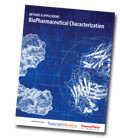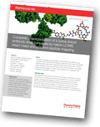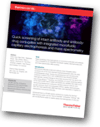Faster, Easier, and Better Biopharmaceutical Intact Mass Analysis
Biopharmaceutical Intact Mass Analysis has traditionally been challenging, and required sample preparation or analysis techniques which led to lengthy data interpretation or results which didn't mirror the actual protein in its native form. Find out how Thermo Scientific provides the ability to not only acquire the highest quality native intact mass data, providing full structural insights, but also perform sub-unit and peptide mapping analyses on a single system.
Orbitrap MS - Built for BioPharma
Prof. Alexander Makarov takes us through the evolution of Obitrap technology for the analysis of biotherapeutics.
Driving Native Mass Spectrometry of Membrane Proteins for Pharmaceutical Research
Unlike conventional proteomics-based mass spectrometry (MS), native MS relies on maintaining a biomolecule’s folded state and any associated noncovalent interactions within the mass spectrometer. Native MS allows direct detection of proteins and proteinligand complexes at unprecedented resolution with the Thermo Scientific™ Q Exactive™ UHMR (Ultra High Mass Range) system. Oxford Mass Technologies specializes in native mass spectrometry platforms for multidimensional analysis of challenging protein targets for the biopharmaceutical industry, and is the first company to offer native MS of membrane proteins, the largest family of drug targets.
Subunits analysis approach for the determination of fucosylation levels in monoclonal antibodies using LC-HRAM-MS
 To highlight middle-up techniques for biotherapeutics N-glycan characterization. To show the importance of high-resolution, accurate-mass MS techniques to confidently quantify mAb N-glycoforms with a special focus on core afucosylation. To demonstrate that the method is easy to optimize, fast, and reproducible.
To highlight middle-up techniques for biotherapeutics N-glycan characterization. To show the importance of high-resolution, accurate-mass MS techniques to confidently quantify mAb N-glycoforms with a special focus on core afucosylation. To demonstrate that the method is easy to optimize, fast, and reproducible.










 Read about...
Read about...
 To demonstrate the capabilities of the Thermo Scientific™ Q Exactive™ BioPharma mass spectrometry platform, particularly the High Mass Range (HMR) Mode for the characterization of antibody samples. The three different operational modes of the BioPharma option are described and application data are presented for the major application workflows.
To demonstrate the capabilities of the Thermo Scientific™ Q Exactive™ BioPharma mass spectrometry platform, particularly the High Mass Range (HMR) Mode for the characterization of antibody samples. The three different operational modes of the BioPharma option are described and application data are presented for the major application workflows.
 To perform complete characterization of the lysine-linked antibody drug conjugate (ADC) trastuzumab emtansine using both intact mass and peptide mapping approaches with a single benchtop mass spectrometer. Critical quality attribute (CQA) measurements include drug-to-antibody ratio (DAR) and glycosylation pattern via intact mass analysis, and conjugation site localization via peptide mapping.
To perform complete characterization of the lysine-linked antibody drug conjugate (ADC) trastuzumab emtansine using both intact mass and peptide mapping approaches with a single benchtop mass spectrometer. Critical quality attribute (CQA) measurements include drug-to-antibody ratio (DAR) and glycosylation pattern via intact mass analysis, and conjugation site localization via peptide mapping.
 The goal here was rapid screening of the heterogeneity of monoclonal antibodies and antibodydrug conjugates by an integrated microfluidic capillary electrophoresis (CE) and mass spectrometry (MS) workflow.
The goal here was rapid screening of the heterogeneity of monoclonal antibodies and antibodydrug conjugates by an integrated microfluidic capillary electrophoresis (CE) and mass spectrometry (MS) workflow.
 Biotherapeutic proteins require a panel of analyses in order to be completely characterized: liquid chromatography-mass spectrometry (LC-MS) orthogonal methods are often used to fully assess the critical structural features that are the basis of instability and safety concerns for biologic drug products. Analytical strategies for deciphering lot-to-lot variations need to be in place for already approved drugs, as well as for drugs in development. Providing high quality data and high resolution profiles of biotherapeutics gives the possibility to outline a pattern or ‘fingerprint’ that needs to be matched to ensure similarity and consistency of biological activity.
Biotherapeutic proteins require a panel of analyses in order to be completely characterized: liquid chromatography-mass spectrometry (LC-MS) orthogonal methods are often used to fully assess the critical structural features that are the basis of instability and safety concerns for biologic drug products. Analytical strategies for deciphering lot-to-lot variations need to be in place for already approved drugs, as well as for drugs in development. Providing high quality data and high resolution profiles of biotherapeutics gives the possibility to outline a pattern or ‘fingerprint’ that needs to be matched to ensure similarity and consistency of biological activity.
 To highlight the use of middle-up techniques for biotherapeutics characterization and biosimilar evaluation. To show the importance of highresolution, accurate-mass MS techniques to characterize mAbs variants at middle-up level, obtaining structural data on glycoforms, lysine truncation and other micro-variants present on the product. To demonstrate the support that subunit analysis can give during product development. To demonstrate that the method is easy to optimize, fast, and reproducible.
To highlight the use of middle-up techniques for biotherapeutics characterization and biosimilar evaluation. To show the importance of highresolution, accurate-mass MS techniques to characterize mAbs variants at middle-up level, obtaining structural data on glycoforms, lysine truncation and other micro-variants present on the product. To demonstrate the support that subunit analysis can give during product development. To demonstrate that the method is easy to optimize, fast, and reproducible.
